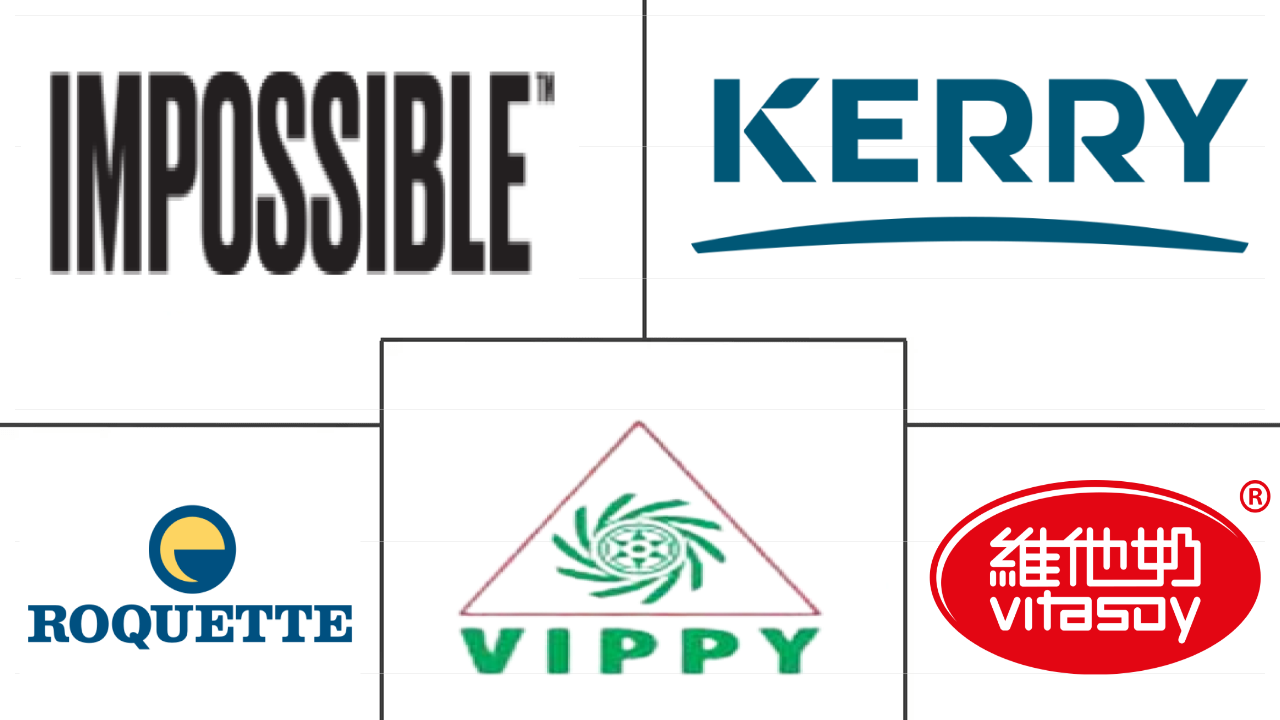Market Size of asia-pacific meat substitutes Industry
| Icons | Lable | Value |
|---|---|---|
|
|
Study Period | 2017 - 2029 |
|
|
Market Size (2024) | USD 2.15 Billion |
|
|
Market Size (2029) | USD 3.84 Billion |
|
|
Largest Share by Type | Textured Vegetable Protein |
|
|
CAGR (2024 - 2029) | 12.35 % |
|
|
Largest Share by Country | China |
|
|
Market Concentration | Low |
Major Players |
||

|
||
|
*Disclaimer: Major Players sorted in no particular order |
Asia-Pacific Meat Substitutes Market Analysis
The Asia-Pacific Meat Substitutes Market size is estimated at 2.15 billion USD in 2024, and is expected to reach 3.84 billion USD by 2029, growing at a CAGR of 12.35% during the forecast period (2024-2029).
2.15 Billion
Market Size in 2024 (USD)
3.84 Billion
Market Size in 2029 (USD)
10.17 %
CAGR (2017-2023)
12.35 %
CAGR (2024-2029)
Largest Segment by Type
60.31 %
value share, Textured Vegetable Protein, 2023
A wide range of applications in various fast food and a similar taste profile to meat are propelling the sales of TVP in the region.
Largest Segment by Country
22.82 %
value share, China, 2023
Owing to the widespread concerns over weight loss and the welfare of the environment and animals, the younger generation in China is embracing the decision to eat less meat.
Fastest-growing Segment by Type
13.36 %
Projected CAGR, Tempeh, 2024-2029
Tempeh is a functional, nutritionally high-protein food ingredient for meat substitutes. It can also be consumed on its own as a meat substitute, which drives its demand.
Fastest-growing Segment by Country
12.87 %
Projected CAGR, India, 2024-2029
Indian manufacturers are focused on capturing the market by creating healthier food product offerings and increasing their sales through e-commerce platforms.
Leading Market Player
8.53 %
market share, Kerry Group PLC, 2022

The company is known for its freeze-dried tofu and seasoned fried tofu product offerings, which include many variants and are all made from certified non-GMO soybeans.
Sustainability and environmental concerns majorly driving the growth of the vegan society
- The Asia-Pacific meat substitutes market witnessed significant growth, recording a CAGR of 9.84% by value over 2017-2022. China has the largest consumption of meat substitutes in Asia-Pacific, followed by India and Japan. In China, the growth is primarily led by the popularity of plant-based meat and protein alternatives. By introducing new dietary guidelines in 2021, the Chinese government announced plans to lower its citizens' meat consumption by 50%. The country's health ministry recommended that an individual consume only between 40 g and 75 g of meat each day. The measures aim to enhance public health while simultaneously attempting to significantly reduce GHG emissions.
- The consumption of meat substitutes has continued to progress over the years, owing to the growing adoption of diets like veganism. In 2022, the sales value of meat substitutes grew by 34.56% by value over 2019. Asian producers of plant-based meat reported record sales as customers looked for healthy alternatives against animal or dairy sources for daily nutrient requirements. Four of the top five global vegetarian markets are in Asia. As of 2020, the top Asian vegetarian population was spread over the following countries: India (29.8%), Indonesia (25.4%), Pakistan (16.8%), and China (3.8%).
- The fastest-growing segment type is tempeh, which is projected to register a CAGR of 13.40% by value during the forecast period. Due to rising demand from consumers and investors, the meat substitute market in Asia is predicted to experience rapid growth. The emergence of new entrants and startups in the region is a positive sign for this trend, along with supportive governments trying to meet their targets for reducing GHG emissions.
Incorporation of plant-based protein into local dishes as fusion is promoting the segment in the market
- India is expected to be the fastest-growing country in the consumption of meat substitutes in Asia-Pacific, and it is projected to register a CAGR of 13.03% by value during the forecast period. Demand for healthy foods is fueling the rapid expansion of plant-based meat substitutes in India. Archer Daniels Midland partnered with Imagine Meats, an Indian producer of plant-based meat substitutes. ADM will source raw ingredients and take part in a technology partnership to manufacture products under the Imagine Meats brand. Similarly, Tiffany Foods, a subsidiary of Allana Group, recently began importing Beyond Meat patties and sausages into the Indian market.
- China holds the major market share. It registered a growth of 39.06% by value from 2018 to 2022. The key international players leading the plant-based market are American companies Impossible Foods and Beyond Meat. These companies entered the Chinese market by various means, including partnering with chains such as Starbucks, KFC, and Taco Bell. Chinese companies entering the market are at an advantage as they understand local tastes and culture and are focusing on local dishes such as dumplings, as well as opting for pork rather than beef flavors.
- In countries like Indonesia, the market for meat substitutes is gaining exponential growth. In 2022, around 78% of the population had tried meat alternative products, (24%) planning to adopt a vegetarian or plant-based diet. With high demand and relatively little competition, brands such as the Meatless Kingdom are likely to see rapid growth. In February 2021, Starbucks introduced a plant-based menu at 57 stores in Jakarta and Bali. Similarly, Pizza Hut and Taco Bell introduced Beyond Meat dishes.
Asia-Pacific Meat Substitutes Industry Segmentation
Tempeh, Textured Vegetable Protein, Tofu are covered as segments by Type. Off-Trade, On-Trade are covered as segments by Distribution Channel. Australia, China, India, Indonesia, Japan, Malaysia, South Korea are covered as segments by Country.
- The Asia-Pacific meat substitutes market witnessed significant growth, recording a CAGR of 9.84% by value over 2017-2022. China has the largest consumption of meat substitutes in Asia-Pacific, followed by India and Japan. In China, the growth is primarily led by the popularity of plant-based meat and protein alternatives. By introducing new dietary guidelines in 2021, the Chinese government announced plans to lower its citizens' meat consumption by 50%. The country's health ministry recommended that an individual consume only between 40 g and 75 g of meat each day. The measures aim to enhance public health while simultaneously attempting to significantly reduce GHG emissions.
- The consumption of meat substitutes has continued to progress over the years, owing to the growing adoption of diets like veganism. In 2022, the sales value of meat substitutes grew by 34.56% by value over 2019. Asian producers of plant-based meat reported record sales as customers looked for healthy alternatives against animal or dairy sources for daily nutrient requirements. Four of the top five global vegetarian markets are in Asia. As of 2020, the top Asian vegetarian population was spread over the following countries: India (29.8%), Indonesia (25.4%), Pakistan (16.8%), and China (3.8%).
- The fastest-growing segment type is tempeh, which is projected to register a CAGR of 13.40% by value during the forecast period. Due to rising demand from consumers and investors, the meat substitute market in Asia is predicted to experience rapid growth. The emergence of new entrants and startups in the region is a positive sign for this trend, along with supportive governments trying to meet their targets for reducing GHG emissions.
| Type | |
| Tempeh | |
| Textured Vegetable Protein | |
| Tofu | |
| Other Meat Substitutes |
| Distribution Channel | ||||||
| ||||||
| On-Trade |
| Country | |
| Australia | |
| China | |
| India | |
| Indonesia | |
| Japan | |
| Malaysia | |
| South Korea | |
| Rest of Asia-Pacific |
Asia-Pacific Meat Substitutes Market Size Summary
The Asia-Pacific meat substitutes market is experiencing robust growth, driven by increasing consumer interest in plant-based diets and dietary shifts towards veganism. This trend is particularly pronounced in China, where government initiatives aim to reduce meat consumption and promote health and sustainability. The market is characterized by a diverse range of products, with tempeh emerging as the fastest-growing segment. The region's market dynamics are further bolstered by the presence of major international players like Impossible Foods and Beyond Meat, who are expanding their footprint through strategic partnerships with local food chains. The market's expansion is also supported by the rise of new entrants and startups, which are capitalizing on the growing demand for healthier food alternatives.
India is poised to be a significant contributor to the market's growth, with increasing demand for plant-based meat substitutes. Collaborations between local producers and international companies, such as Archer Daniels Midland's partnership with Imagine Meats, are facilitating the introduction of innovative products. Despite challenges like high soybean prices affecting tempeh production, the market remains fragmented with numerous players vying for market share. The Asia-Pacific region's unique consumer preferences and cultural nuances present both opportunities and challenges for market participants, as they strive to meet the rising demand for sustainable and nutritious food options.
Asia-Pacific Meat Substitutes Market Size - Table of Contents
-
1. MARKET SEGMENTATION (includes market size in Value in USD, Forecasts up to 2029 and analysis of growth prospects)
-
1.1 Type
-
1.1.1 Tempeh
-
1.1.2 Textured Vegetable Protein
-
1.1.3 Tofu
-
1.1.4 Other Meat Substitutes
-
-
1.2 Distribution Channel
-
1.2.1 Off-Trade
-
1.2.1.1 Convenience Stores
-
1.2.1.2 Online Channel
-
1.2.1.3 Supermarkets and Hypermarkets
-
1.2.1.4 Others
-
-
1.2.2 On-Trade
-
-
1.3 Country
-
1.3.1 Australia
-
1.3.2 China
-
1.3.3 India
-
1.3.4 Indonesia
-
1.3.5 Japan
-
1.3.6 Malaysia
-
1.3.7 South Korea
-
1.3.8 Rest of Asia-Pacific
-
-
Asia-Pacific Meat Substitutes Market Size FAQs
How big is the Asia-Pacific Meat Substitutes Market?
The Asia-Pacific Meat Substitutes Market size is expected to reach USD 2.15 billion in 2024 and grow at a CAGR of 12.35% to reach USD 3.84 billion by 2029.
What is the current Asia-Pacific Meat Substitutes Market size?
In 2024, the Asia-Pacific Meat Substitutes Market size is expected to reach USD 2.15 billion.

